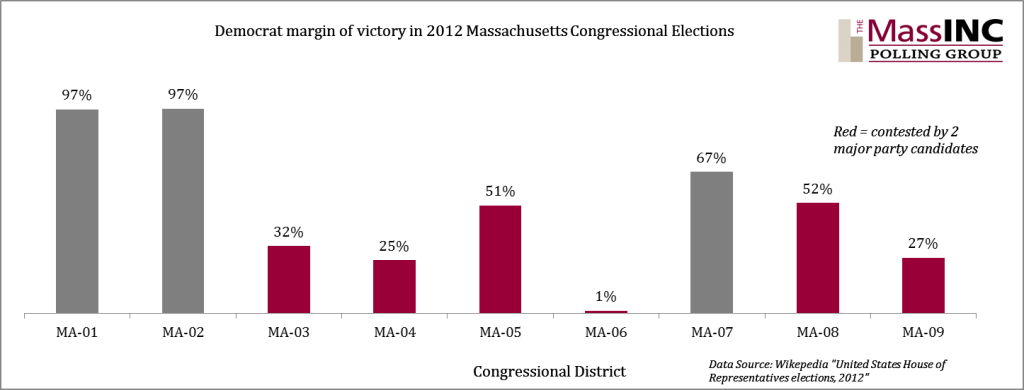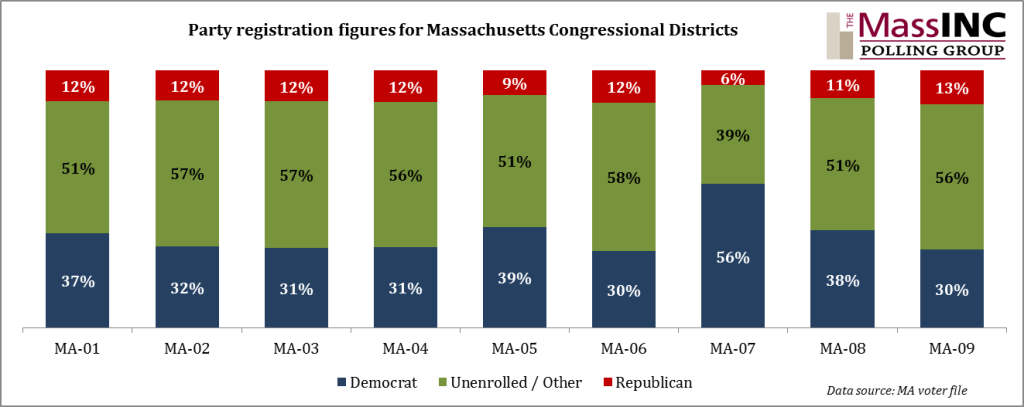Where can the GOP Win? Ranking the Massachusetts Congressional Districts
Earlier this week WBUR examined the reasons behind the GOP’s record-setting losing streak in Massachusetts Congressional elections. And in a companion post here, we noted that Republicans seem to be taking the first step towards breaking that streak: running more candidates in races that in previous years had gone uncontested. But can they win? Are there any districts where they have a real shot in 2014?

Looking at results from recent Congressional and statewide races suggests it will be an uphill battle in any district, but the 6th gives them the best chance, as it did in 2012. The district held the closest 2012 congressional election, where former State Senator Richard Tisei nearly beat John Tierney, an incumbent dogged by scandal. Tierney’s troubles presented an excellent opportunity for a GOP pickup, but strong Democratic turnout for President Obama and Elizabeth Warren, combined with the presence of a third-party candidate (Libertarian Daniel Fishman, who siphoned off nearly 5% of the vote) helped the incumbent squeak out the narrowest of victories. Recent statewide elections have also shown the 6th to be among the most favorable toward Republicans, with both Scott Brown and Gabriel Gomez winning narrow victories there in their respective Senate races.
As the chart below shows, in 2012, Republicans lost by 25 points or more in the other 5 districts they contested. But looking at statewide elections results and party registration figures by congressional district shows which districts contain more potentially favorable terrain for Republicans. For the moment, we are leaving aside the specific candidate dynamics of each race and focusing only on evaluating the terrain. It is too early to know what news stories may develop, whether any retirements may leave any seats vacant, and the quality of candidates Republicans might field.
With this in mind, the table below ranks the districts in terms of their potential competitiveness, based on recent elections as well as party registration dynamics. This listing places the 9th Congressional district (Bill Keating), the 3rd (Nikki Tsongas) and the 4th (Joseph Kennedy III) as the most potentially competitive. In each place, at least 1 of the 2 recent Senate elections went for the Republican, and the party registration gap is narrower than elsewhere.
To be clear, none of the districts feature more Republicans than Democrats. As Mass GOP chair Kristen Hughes noted in the WBUR piece, making inroads with unenrolled voters will have to be a key component of any successful Republican campaign in Massachusetts. Democrats outnumber Republicans on the voter rolls by anywhere from just under than 3 to 1 to more than 9 to 1 (in the 7th, which comprises Boston, Cambridge, Somerville, and other inner core cites). But in eight of nine districts, a majority of voters are unenrolled. The 3rd, 4th, 6th and 9th districts have the most favorable ratio for the GOP: lower than average Democratic enrollment, some Republican presence and a larger share of unenrolled voters.
Of course, the electorate is only part of the equation. Massachusetts voters have traditionally favored Democratic incumbent candidates, nearly always returning them to office. The most favorable circumstance would of course be an open seat due to retirement or other cause. Barring that, a Republican running in any of the four nominally competitive district will thus have to unseat Nikki Tsongas, Joseph Kennedy III, Tierney or Bill Keating. Of these four incumbents, Tierney has already drawn a primary challenger, Harvard graduate and Iraq war veteran Seth Moulton. But the 9th may also be hospitable to a Republican. That district absorbed much of the 10th in the last round of redistricting. The last race in the 10th, to succeed the retiring William Delahunt in 2010, saw Keating defeat Republican Jeff Perry by only 5 points.



